
Deformation behavior of materials and minerals under high pressure
1. Deformation and phase transition mechanisms of typical ceramics under pressure
Investigation of the mechanical properties of minerals under high pressure, including the plastic and elastic deformation behavior as well as the rheology, is crucial for understanding the dynamic processes during Earth’s history that produce heterogeneity and anisotropy and has become of great interest to the geophysics community. On the other hand, the mechanical properties and phase transition mechanisms of functional ceramics under extreme compression are also of considerable importance to technological applications. Based on the technology of radial x-ray diffraction in a diamond anvil cell (rDAC-XRD), we have studied in situ the deformation behavior of several typical ceramic compounds under non-hydrostatic pressure and successfully revealed the texture evolution under pressure and the phase transition mechanism. For example, dominant slip systems and orientation relationships have been revealed in zircon-type compounds [PRL, 2016], and a simple variant selection effect has been observed during the cubic to orthorhombic phase transition in Mn2O3 [PNAS, 2019]. MnO2 was also studied as a representative system of the MO2 family to understand the deformation and slip systems of the high-pressure CaCl2-type phase [PRM, 2022].
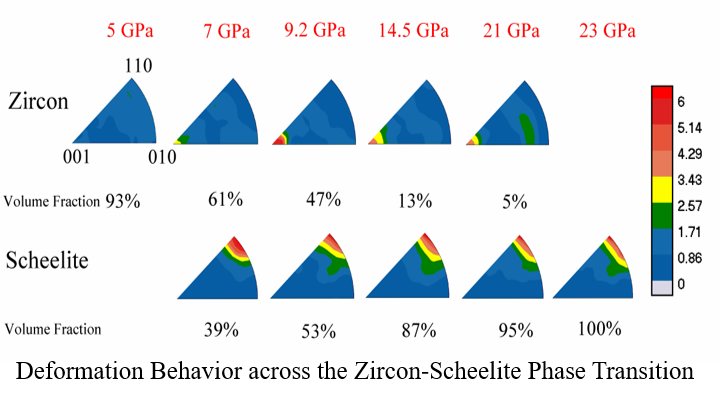
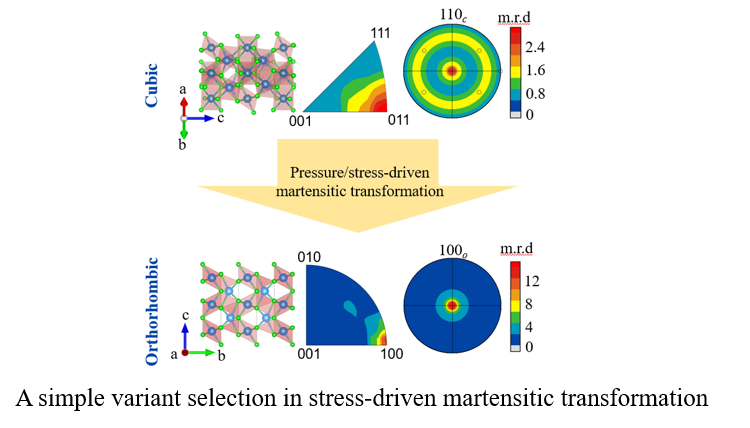
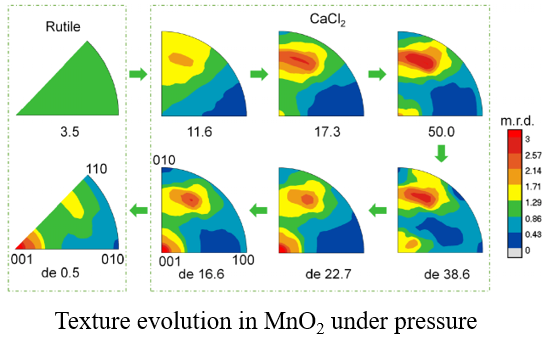
2. Mechanical properties of high-entropy materials under pressure
The excellent mechanical properties of high-entropy materials make them promising materials for advances in science and technology. However, their behavior under high pressure and the underlying mechanism of their deformation is not well understood. Here, we in-situ studied the deformation behavior of high-entropy alloy MoNbTaVW and high-entropy oxide MgCoNiCuZnO under high pressure via radial x-ray diffraction in a diamond anvil cell (rDAC-XRD). By comparing with metal W, it’s proved that the active dislocation behavior is mainly responsible for the high strength in MoNbTaVW under compression [J. Alloys Compd., 2021]. A possible slip system transition process is also proposed for MgCoNiCuZnO based on the lattice strain and texture evolution under high pressure[Scr. Mater. 2022]. In the meantime, a series of high-entropy carbides and nitrides have been synthesized. Their compressibility and phase stability have been investigated via axial x-ray diffraction under high pressure.
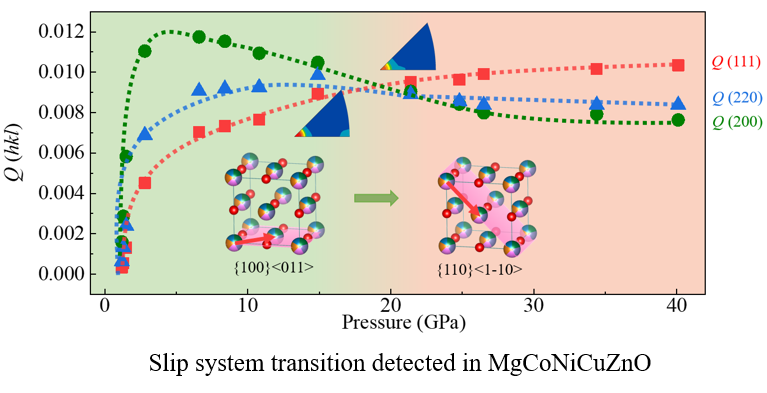
3. Size effect on the deformation behavior of functional ceramics under compression
Stiffness and ductility can be achieved by reducing the grain size of ceramics to the nanometer scale. However, the deformation mechanism of nanoceramics is still controversial due to technical limitations. The technique of rDAC-XRD provides the opportunity to in-situ study the deformation behaviors of ceramics with different size distributions. Our work on nano-TiN suggests that the reduction in grain size to the nanoscale improves both the stiffness and ductility of TiN via a dislocation-mediated mechanism [PRM, 2024].
Tuning the electronic properties of layered materials via pressure
1. Quasi-one-dimensional transition metal trichalcogenides (TMTCs)
Various transition metal trichalcogenides (TMTC) show unique electronic properties, such as metal-insulator transition, topological insulator, and even superconducting transition. Currently, almost all metallic TMTC compounds can show superconductivity either at ambient pressure or at high pressure. However, most TMTC compounds are semiconductors and even insulators. To find out if superconductivity could exist in non-metallic TMTC compounds by artificial manipulation, We studied the electronic behavior of highly insulating HfS3 and successfully observed the superconducting transition under high pressure. The results reveal that all TMTCs may be superconductors and open a new avenue to explore the abundant emergent phenomena in the TMTC material family [JACS, 2023].
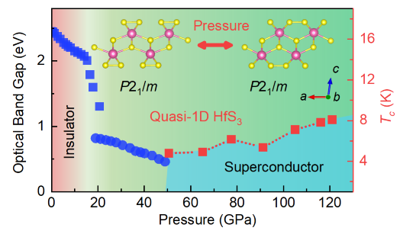
2. 2D transition metal dichalcogenides (TMDCs)
The manipulation of electronic properties in 2D TMDCs is of great importance for both device design and fundamental research. Pressure engineering has been a powerful tool to tune the physical properties of MX2 materials since the interlayer interaction is sensitive to external pressure. Metal-insulator transition and superconducting transition have been realized in HfS2 [PRB, 2023] and SnS2 [PRB, 2022] with high-pressure treatment.
3. 3D Binary metal sulfides
Binary metal sulfides are a large material family with distinct physical behavior. Here, we report the superconductivity observed in PbS using pressure engineering. PbS undergoes a series of electronic phase transitions upon compression, and superconductivity occurs above 23.9 GPa in the high-pressure CsCl-type cubic phase. Marginally high Tc ≈ 12.3 K is observed at 19.1 GPa during pressure release. The magnetic field effect verifies the superconductivity with possible multiband features. It is noted that PbS is one of the few binary metal sulfide superconductors with a Tc above 10 K. This work demonstrates that PbS has a high Tc under a moderate pressure due to the chemical “precompression” effect, which is very close to the Tc in pure sulfur at ∼100 GPa. PbS also shows unexpected multiband behavior in the cubic structure, benefiting the study of pressure-induced superconductivity and the underlying mechanism in metal sulfide compounds [PRB, 2023].
4. Pressure-induced superconductivity in ferroelectric semiconductors
Ferroelectricity and superconductivity are prominent yet distinct quantum phenomena; materials exhibiting both phenomena are rare and of great fundamental and practical interest. Here, combining ab initio calculations and in situ measurements, we show that ferroelectric SnPS3 turns into a superconductor under pressure at 31.7 GPa, accompanied by a structural phase transition. Electronic band structure calculations reveal a partial flat band near the Fermi energy in compressed SnPS3, suggesting correlation effects as a possible origin of the observed superconducting state. The discovery of a pressure-induced ferroelectric-to-superconductor transition in SnPS3 raises the prospect of establishing this intriguing quantum phenomenon among a large class of metal phosphorous trichalcogenides, thereby broadening the material basis to elucidate the underlying physics [PRB, 2023].